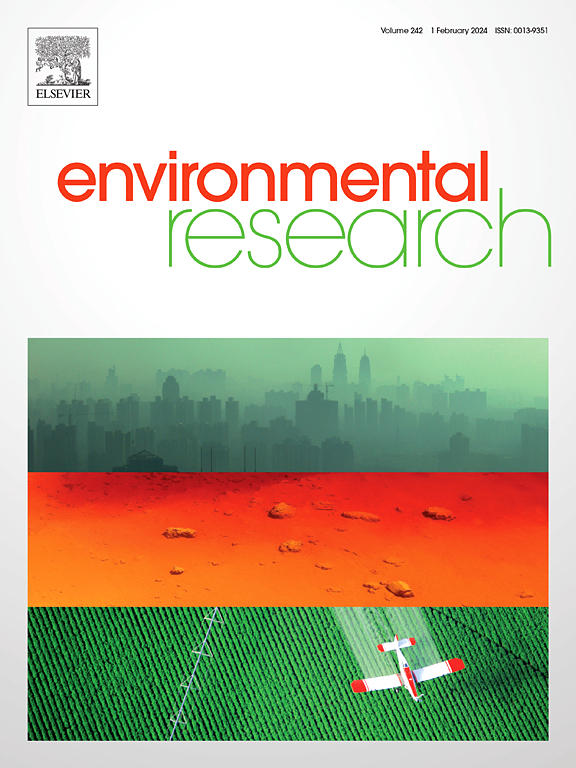Elfe队列中母亲农药暴露与妊娠期糖尿病的关系
IF 7.7
2区 环境科学与生态学
Q1 ENVIRONMENTAL SCIENCES
引用次数: 0
摘要
背景:妊娠期糖尿病(GDM)增加了后代不良围产期结局和代谢紊乱的风险。一些干扰内分泌的化学物质被认为会干扰葡萄糖代谢。我们的目的是评估非职业接触农药与GDM风险之间的关系。方法研究对象为来自法国Elfe队列的11 512名女性(其中791名患有GDM)。在使用毒物基因组学方法确定的114种可疑农药中,对检测频率≥10%的62种农药进行了分析,涉及三个暴露源:住宅使用(自我报告,n = 18)、农业(地理信息系统,n = 14)和饮食(通过食物频率问卷和食品中农药残留监测数据估计,n = 30)。使用单源和多源调整后的logistic回归模型检验农药暴露(无或低与高)与GDM发生之间的关系。结果在多源模型中,饮食暴露于草甘膦(aOR = 0.6, 95% CI: 0.5,0.9)或农业暴露(aOR = 0.8, 95% CI:0.6,1.0)与较低的GDM发生率相关。两种膳食农药:环氧康唑(aOR = 0.6, 95% CI: 0.5,0.8)和戊康唑(aOR = 0.8, 95% CI: 0.6,1.0)也有相同的效果。饮食中暴露于氯氰菊酯(aOR = 1.2, 95% CI:1.0,1.5)和农业中暴露于氯氰菊酯(aOR = 1.4, 95% CI:1.1,1.9)与较高的GDM发生率相关。没有发现农药的住宅使用有显著的关联。结论基于毒物基因组学的研究确定了5种农药通过农业或饮食暴露与GDM相关。这些发现为研究GDM的环境因素提供了新的见解。需要进一步的研究来阐明潜在的毒理学机制并确认这些关联。本文章由计算机程序翻译,如有差异,请以英文原文为准。

Maternal exposure to pesticides and gestational diabetes mellitus in the Elfe cohort
Background
Gestational diabetes mellitus (GDM) increases risks of adverse perinatal outcomes and metabolic disorders in offspring. Some endocrine-disrupting chemicals are presumed to interfere with glucose metabolism. We aimed to assess the association between non-occupational exposures to pesticides and the risk of GDM.
Methods
The study was conducted on 11 512 women (791 with GDM) from the French nationwide Elfe cohort. Among 114 suspected pesticides identified using a toxicogenomic approach, 62 with detection frequency ≥10 % were analyzed across three sources of exposure: residential use (self-reported, n = 18), agricultural (geographic information system, n = 14) and dietary (estimated by a food-frequency questionnaire and monitoring data of pesticide residues in foods, n = 30). The association between exposure to pesticides (no or low vs. high) and the occurrence of GDM was tested with single and multi-source adjusted logistic regression models.
Results
In the multi-source model, dietary exposure to glyphosate (aOR = 0.6, 95 %CI: 0.5,0.9) or agricultural exposure (aOR = 0.8, 95 %CI:0.6,1.0) were associated with lower odds of GDM. The same effect was identified for two dietary pesticides: epoxiconazole (aOR = 0.6, 95 %CI: 0.5,0.8) and penconazole (aOR = 0.8, 95 %CI: 0.6,1.0). Dietary exposure to cypermethrin (aOR = 1.2, 95 %CI:1.0,1.5) and agricultural exposure to myclobutanil (aOR = 1.4, 95 %CI:1.1,1.9) were associated with higher odds of GDM. No significant association was identified for the residential use of pesticides.
Conclusion
This toxico-genomic-based study identifies five pesticides associated with GDM through agricultural or dietary exposure. These findings provide new insights into environmental contributors to GDM. Further research is needed to elucidate the underlying toxicological mechanisms and confirm these associations.
求助全文
通过发布文献求助,成功后即可免费获取论文全文。
去求助
来源期刊

Environmental Research
环境科学-公共卫生、环境卫生与职业卫生
CiteScore
12.60
自引率
8.40%
发文量
2480
审稿时长
4.7 months
期刊介绍:
The Environmental Research journal presents a broad range of interdisciplinary research, focused on addressing worldwide environmental concerns and featuring innovative findings. Our publication strives to explore relevant anthropogenic issues across various environmental sectors, showcasing practical applications in real-life settings.
 求助内容:
求助内容: 应助结果提醒方式:
应助结果提醒方式:


